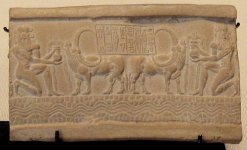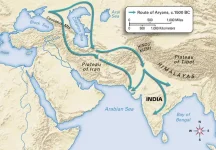suriya
Full Member
- Jan 14, 2024
- 220
- 332
- Country of Origin

- Country of Residence

Indus Valley Civilisation is largest source of ancestry for South Asians: David Reich
Synopsis
For the first time, we have a genetic model that fits statistically for most present-day South Asians: mixture of IVC-like people, and other (smaller contributions) from other populations.
David Reich, a professor of Harvard Medical School, partnered with Indian archaeologist Vasant Shinde and other experts to study skeletal DNA from Rakhigarhi, an Indus Valley Civilisation (IVC) site. Their study, published last week in the journal ‘Cell’, has generated a debate with its new assessments on the IVC period and the extent of its imprint on modern day South Asia. Excerpts from an email interview with David Reich by ET:
Our study finds that the single largest genetic contributor to people living in South Asia today, is people from a population of which the Indus Valley Civilisation individual we analysed was a part. Some people in South Asia have a modest, but meaningful proportion of their ancestry from people from the Steppe, north of the Black and Caspian Seas; the number ranges from 0-30%. People with this ancestry almost certainly spread into South Asia from the north 4,000-3,500 years ago.
Many people question how the genetic evidence from the IVC, which predates the Aryan phase, can establish that there was no mass migration or invasion.
I think the identification of the ancestry of people living at the time of the IVC phase in South Asia does meaningfully contribute to our understanding of what happened later. For the first time, we have a genetic model that fits statistically for most present-day South Asians: mixture of IVC-like people, and other (smaller
contributions) from other populations for which we have genetic data. This allows us to be specific about what other populations contributed to present-day South Asians, and when the mix occurred.
Shinde has stated that the Vedic era followed naturally from the Harappan /Indus Valley civilisations and was not introduced by outsiders/Aryans. Would you agree?
This is an archaeological question and not one that I can comment on authoritatively as a geneticist. It is true that people, with ancestry like that of the IVC individual(s) we sequenced, were the primary source of ancestry of people in South Asia. So, it is natural to expect that they made important cultural contributions as well. Archaeologically, the material cultures of the early Vedic period have little obvious connections to those from the Steppe. So, even though there was a substantial
(if quantitatively modest) genetic contribution from the north, the material cultural contribution may be hard to detect. We see something similar in some instances in the archaeological and ancient DNA record of Europe, as discussed in the final paragraphs of our ‘Science’ paper.
Full report:

Indus Valley Civilisation is largest source of ancestry for South Asians: David Reich
For the first time, we have a genetic model that fits statistically for most present-day South Asians: mixture of IVC-like people, and other (smaller contributions) from other populations.
Source:
news paper
news paper








